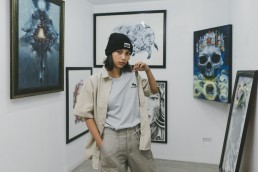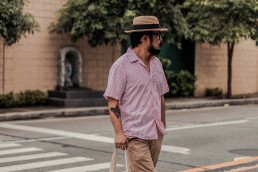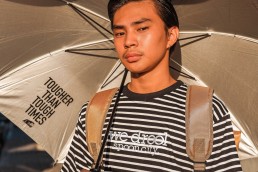Alisson Shore is an artist whose boundaries are only limited by his mood and form. Music and its many veins have long played an important factor in his formative years—familial ties and connections to musical practice, the hard appeal of Fliptop in its heyday, and apprenticeships where the art can be engaged with directly.
But rather than sticking to that vein of a musician, Alisson doesn’t fancy himself a one-trick pony, but as a budding and blooming creative with many brushes to paint with and many strokes to make. We got to talk with him about his perspective on the world of art, music, the veins of creativity that exist today, and how this mindset applies to the very essence of the modern Filipino creative, both in professional and personal aspects.

Who is Alisson Shore, and how did he get here?
I once thought of only going by Alisson, but it didn’t work by SEO standards so the next best thing was that I’m always trying to bridge the gap between the underground and the mainstream, so “Shore” came on—the ground, me, and then the ocean. Like I’m between the two worlds, always trying to relay one to the other.
Music was everywhere when I was growing up. From my parents to my grandparents, and even to extended family, we had music playing almost constantly. But it started to become a serious passion of mine when I got hold of my grandparent’s massive music CD collection. I started gravitating toward writing and composing. To this day, we still have those discs in storage.
Both my mom and grandmother were both into singing, but only recreationally. My mom, who loved to sing at parties, even used to leave this old-timey, 50’s-esque radio around, where she would play and sing the classics – classic jazz, really extravagant and vibrato-filled singing. These heavily influenced how and what my earlier music tastes were. My uncle would also bring his Starbucks music mix in a CD, and would just have it there for me to plug in, jam, and vibe to.
Have your thoughts on the music landscape, both in local and global aspects, changed much?
Back when I was younger, one of the best ways to listen to old music that was not on the radio was by using a multiplex tape recorder. Other than that, you really just had to stay tuned in and hope that the song would play on your station.
But now? Open a browser, or download an app on your phone, and you’re good to go. You can go to YouTube, Spotify, and Soundcloud anytime. Discoverability, from the local and global, in a decade, improved and accelerated like crazy. Back when I started in music, this was one of the reasons I preferred doing things in a DIY way. I made the music, I made the art, and I collaborated with video producers. I did what I could, and the growing tech sure eased things along.
Part of my come-up was with Flip Music Records, under Viva, and this was my immersion in the music scene to begin with; things that would have never happened if it weren’t for discoverability. It was here that I saw how, on a professional level, music was made, produced, and played on the radio, and gave me the right exposure and connections to work with other artists from Viva while still finding the time to work on my own songs.
It wasn’t long until I realized that I was capable of so much more. So, I quit my job, went back home to Batangas, and pursued freelancing – magazine design. All the while, I put money in the bag, with music on my mind.

What made you choose to start and stay unsigned as a musician?
There’s a lot of freedom in finding your own way. Like, right now, I don’t consider myself as just a musician but more of a creator. Music is but one way to express art. Design, fashion, and merchandising, among other things are multiple ways of drawing inspiration and stimulating my creative energy. I just love the act of creation, but most especially in music. These things keep me on my toes, keep me busy, and keep me stimulated and thriving.
My biggest interest right now is in visual arts and physical art projects. And I don’t mean collecting art toys and figurines, but on homemade items like 3D printing and scaling models. I just really love tinkering with physical things, that act of fidgeting with something to get the process.
In a way, my enjoyment of versatility felt like, even in music, that ‘labels’ would box me in. Nothing kills creativity and enthusiasm faster than being boxed in.
How do you feel about today’s music and media landscape as a creator?
A lot of people would be ashamed to admit this, but most listeners haven’t changed their preferred theme: love songs. The embarrassment comes with the idea that these songs are considered baduy (tacky), and so ‘mainstream’, even corny. But obviously, you can still have both!
Listen to your love ballads without sacrificing quality, uniqueness, or appeal. Take for example, Wish 107.5. Wish used to only get big names like Darren Espanto, but now they’re getting artists like me, someone from the underground alongside other small-time acts that bigger labels wouldn’t even think about. It was only a few years ago when people started feeling the shift of music going off-radio and more onto social media.
There’s also TikTok. I can’t exaggerate just how much that 15-second-on-loop format has made big changes in how a listener is captivated by a song. Consequently, this even affects how a producer or a songwriter creates a song. It’s done things on the creativity and the freedom, the painlessness that one can enjoy from making music for the self, rather than for these platforms that make money off you.

I’ve thought about it this way: write for you, then for the audience. Write and perform because you love it, and find a way to focus on them, too.
What is the most important thing about a musician’s or artist’s audience?
Art is meant to be shared; find a balance between what the audience likes and what you like.
Viewership and audience play such a huge role in keeping the system thriving and making sure that the ecosystem is resolute. The platform thrives with an audience, the system thrives with patrons. I’ve thought about it this way: write for you, then for the audience. Write and perform because you love it, and find a way to focus on them, too.
I’m thankful when someone likes my music because that means they vibe with it. Adversely, I’m just as thankful when they don’t; that’s when I know when I’ve fallen off, or I need a bit more time on a certain track or theme.
On the other hand, balance comes from knowing when you’re listening to yourself, to when you’re listening only to yourself. How you create your music versus how you create your music that would attract and retain an active audience is that balance that’s been key for many in the music industry, not just me. You have to learn that at some point, you’re not writing just for you, not anymore. Your audience becomes a part of you. Your listeners, your fans, your collaborators, your co-writers. Write for you, and write for them.
Your audience becomes a part of you. Your listeners, your fans, your collaborators, your co-writers. Write for you, and write for them.
What’s something you’ve picked up from your years starting out, getting traction, and releasing your own tracks?
Art is a constant evolution, always pushing somewhere and never boxed in.
Make a lot of music. Don’t think about whether it’s ugly or not. Do what you think is right at that moment. Let nobody else destroy your energy. Create your art, let the people hear it, let the mentors hear it, and then take what they say to heart… but here’s the kick: don’t apply it, at least for that project. Bring it to whatever else you’re working on. I don’t like to be confined to select labels or categories; be titled an artist only or a musician only or a designer only. Always open your mind and your artistry in other areas.
Give time to rest. You can’t create when you’re burnt out. At the same time, and coming hand-in-hand with artistry and evolution, you must also realize when you do have a limit. You rest when you can and rest to grow. You rest so that there’s clarity.
And finally, be grateful. It’s a blessing or a lesson; all part of the process. Kahit saang multiverse ako galing (whatever part of the multiverse I come from), I would still do this – make music and design, all of that. I regret nothing. This is something that I’ve done and still do. Make a lot of music and don’t focus too hard on the quality as you make them. Make sure it feels right, both in the moment, and in hindsight. Don’t let anyone destroy the energy during this creation phase, stop interruption as much as you can.
How do you feel about musical styles, genres, and methods of categorization? Is the label-defining and claiming just as important to you?
I never think about the end-product. I think about the feeling. I always think about how music is felt by the listener. Melancholy? Rage? Am I trying to make the listener feel happy about a certain selection of songs? Then, there’s the thought process of instrumentation, samples used, and textures that help to show that feeling. Then, at least for me, the imagery that comes afterward is the most important. All of the feelings, down to the instrumentation, flow through a sort of journey, like a rollercoaster, and where that ends depends on the imagery I produce. This is primarily why I enjoy heading and having a creative voice in the music video direction, as well.
I’ve noticed in a lot of your work, there’s an emphasis on identity and writing within phases, hats—like eras or maybe stages of your musical life. Can you speak more about the paradigm shift that comes with changing a name, which groups you’re playing and collaborating with, and playing to different crowds?
I think it’s always been very me to wear different hats. I used to DJ, which comes with familiarity with the music, and I also did design work. There was a time when I used to play at electronic shows alongside other DJs. I’ll be hopping aside noise ambient acts, explorative and otherworldly music sets now, and then the next day I jump onto a show that’s hip hop or R&B, things that appeal more to mainstream or common sensibilities.
I just see the beauty in the art that I immerse in without thinking too much about if I belong there and how else I ‘fit in.’ At the end of the day, I’m just being myself. I just go along with these types of art. I just put myself where I can participate or where I can benefit, where I can grow the most and experience the most things.
Come as you are, and not as you expect or demand. It’s humbling but also the most maximizing thing that you can do to thrive creatively and improve your various skill sets.

I just put myself where I can participate or where I can benefit, where I can grow the most and experience the most things.
What’s the most daunting aspect of music creation?
In terms of anxieties, there’s nothing like the post-launch woes of having just dropped a track. I would need to distract myself ASAP with whatever was around; be it survival games, or resource management games. Something about the fidgeting that feels therapeutic.
Imposter syndrome is a bitch. A sudden rush of shame, instant regret, like I’ve committed a grave mistake. I don’t even know where it came from, or why I felt this way, but it’s a self-punishment of so many different and degrading questions. Am I a musician? Do I deserve it? It never lasts long, but man, it sucks. Of course, it really all is in the game, and something you easily get used to, but it doesn’t mean it’s not nerve-wracking when it comes, though.
How do you overcome these feelings and continue to create music?
Much of my experience with music, especially in line with releasing and public perception, has involved so much thought about whether I enjoyed the publicity or not. In turn, music-making eventually became mostly that: the perception of creativity, rather than just the joy of creating.
At the end of the day, when you’re putting yourself out there for public consumption, you’re releasing a part of yourself to improve and grow. All those thoughts of whether the right parts of you and your art are being absorbed, they eventually fade, and at the end it all becomes about showing up.
Of course, there’s a selfish aspect to it, too. Part of impostor syndrome is the feeling that no matter what you do and how you do it, there’s always going to be something missing. So it’s inevitable for someone to think, “Someone’s going to do ‘me’ better than me.”
But that’s the thing: they can’t. Only I’m me, and whoever comes in at the end can’t do me better than myself; that’s just the nature of it. There is no competing, only inspiring, conspiring, and cooperating. I’m unique, you’re unique; we’re in this together. And besides, if someone tried stealing my ‘game’ from me then that only means that I have influence, in a way, that someone is literally taking inspiration from me and making it something their own.
Especially with global audiences and corporations in the mix, you can’t just play this “me vs them” game and use that as the mentality in being your own artist. As cheesy as it is, when writing music and creating art, there is no competition. There just isn’t.
If you could change something in the entertainment industry, what would it be?
I can talk about the love, loss, and longevity that comes with being a musician. But because so many artists lack the expertise of dealing with music executives, they don’t realize the importance of their rights—at the very least, who holds it and how. I’ve even been to gigs where I couldn’t perform my song because of rights.
Raise the awareness at the onset. At the very least have a stronger insistence to have older musicians—with all their experience—support and inform the newer ones so that they don’t make the same mistakes. Know your rights, know your power, know your music community—at any cost. There is strength in numbers, after all.
Thankfully, there are a lot more creator and artist protection these days, a lot more power for you to “own your masters,” so to speak. More niches, and better buying power by listeners, even with very painstakingly slow progress—such is music in a third world country like the Philippines.
The world would be a better place if we could all own the art we create and be supported by each other, every step of the way.

CREDITS
WRITER Jean-Pierre Ditona
EDITOR Tricia Quintero
PHOTOGRAPHER Zaldine Alvaro
SUPPORT PURVEYR
If you like this story and would love to read more like it, we hope you can support us for as low as ₱100. This will help us continue what we do and feature more stories of creative Filipinos. You can subscribe to the fund or send us a tip.







